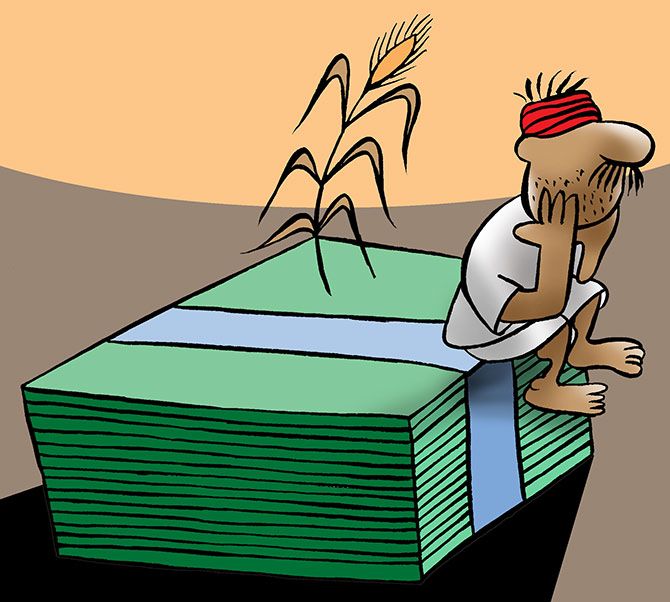Government’s objective is to bring down the cost of cultivation through efficient use of fertilisers and agro chemicals, and increase in realisation. It is, thus, planning to connect 200 agricultural mandis with electronic National Agricultural Mandis this year and 225 next year, to enable farmers to sell their produce hassle-free online.
Illustration: Uttam Ghosh/Rediff.com

The interim Union Budget scheduled for presentation in the Parliament on February 1 will be dedicated to farmers as a government’s commitment to double farmers’ income by 2022, Union Agricultural Minister Radha Mohan Singh said on the sidelines of a conference in Mumbai on Wednesday.
In Budget 2018, the Union Cabinet had approved a new umbrella scheme, the “Pradhan Mantri Annadata Aay SanraksHan Abhiyan’ (PM-AASHA), to ensure remunerative prices for farm produce.
In this process, the government increased the minimum support price to 1.5 times the production cost.
The government has introduced several farmer-friendly schemes the past four years, which in some cases, have yielded desired results, the minister said.
Of them, the most effective and immediate was the 10 per cent cut in seed prices, which brought great relief to farmers across the country in terms of a proportionate decline in the cost of cultivation.
“Impressive growth has been recorded in production of food grains, pulses, milk and also in horticulture and fisheries, with the value of horticulture produce surpassing that of agriculture in 2018, for the first ever in the history of agriculture in India.
"To strengthen farmers, therefore, the budgetary outlay of the Ministry of Agriculture has been increased to Rs 211,694 crore (Rs 2.12 trillion) during 2014-19.
"Pradhan Mantri Fasal Bima Yojana, a landmark scheme to reduce the risks associated with agriculture, is being implemented across the country,” the minister said.
The one–day seminar was organised by the Crop Care Federation of India (CCFI) on the theme: Government, Industry and Farmer can work together to make farming more profitable.
Rajju Shroff, chairman, UPL Ltd, one of India’s largest agro chemical companies, emphasised the need for all stakeholders to work in the agricultural value chain together, with favourable government policies to make farming profitable.
“Today, farmers are not willing to pass on their inherited cultivating activity to their kids due to distress.
"We need to think how to make farming profitable, given that agriculture is the backbone of the country’s economy,” said Sudhir Mungantiwar, Minister of Finance, Planning and Forest, Government of Maharashtra.
Meanwhile, the government’s objective is to bring down the cost of cultivation through efficient use of fertilisers and agro chemicals, and increase in realisation.
To be successful in this attempt, the government is planning to connect 200 agricultural mandis with electronic National Agricultural Mandis (eNAM) this year and 225 next year, to enable farmers to sell their produce hassle-free online.
With 585 mandis already being connected with eNAM, an overall 1,000 mandis would be linked to this nationwide farm portal, which will enable farmers to sell their produce in deficit regions at reasonable prices.
The government aims to garner all 22,000 mandis and small weekly or semi-weekly bazaars by 2022.
“The government aims to bring down the role of the middlemen (arhatiyas) so that farmers get the full price paid by consumers.
"The government has also introduced the soil health card and built many new centres to check soil health.
"It is now looking to introduce a potable soil health check machine,” said Singh.
The government is implementing several programmes to develop the agricultural sector and improve the economic condition of farmers, the minister added.
Issues such as reduction in post-harvest crop losses and alternative sources of income are also being worked out to improve farmers’ income, he said.












 © 2025
© 2025